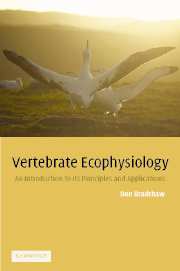Book contents
- Frontmatter
- Contents
- Introduction
- 1 Homeostasis: a fundamental organising paradigm in ecophysiology
- 2 Stress: the concept and the reality
- 3 Basic methods used in ecophysiological studies
- 4 Turnover methodology: theory and practice
- 5 Case studies of stress: incidence and intensity
- 6 Survival in deserts
- 7 Torpor and hibernation in cold climates
- 8 Marine birds and mammals
- 9 Conclusion
- Appendix 1 Population estimation methods
- Appendix 2 Estimation of food intake in Tiliqua rugosa
- Appendix 3 Simultaneous measurement of sodium and potassium concentration in plasma or urine using the IL 143 digital flame photometer
- Appendix 4 Determination of plasma urea nitrogen
- Appendix 5 Radioimmunoassay of testosterone in plasma
- Appendix 6 Preparation of ‘stripped plasma’
- Appendix 7 Radioimmunoassay of testosterone in faeces
- Appendix 8 The comparative method
- Appendix 9 Basic turnover equations
- References
- Index
5 - Case studies of stress: incidence and intensity
Published online by Cambridge University Press: 05 June 2012
- Frontmatter
- Contents
- Introduction
- 1 Homeostasis: a fundamental organising paradigm in ecophysiology
- 2 Stress: the concept and the reality
- 3 Basic methods used in ecophysiological studies
- 4 Turnover methodology: theory and practice
- 5 Case studies of stress: incidence and intensity
- 6 Survival in deserts
- 7 Torpor and hibernation in cold climates
- 8 Marine birds and mammals
- 9 Conclusion
- Appendix 1 Population estimation methods
- Appendix 2 Estimation of food intake in Tiliqua rugosa
- Appendix 3 Simultaneous measurement of sodium and potassium concentration in plasma or urine using the IL 143 digital flame photometer
- Appendix 4 Determination of plasma urea nitrogen
- Appendix 5 Radioimmunoassay of testosterone in plasma
- Appendix 6 Preparation of ‘stripped plasma’
- Appendix 7 Radioimmunoassay of testosterone in faeces
- Appendix 8 The comparative method
- Appendix 9 Basic turnover equations
- References
- Index
Summary
We have already examined in Chapter 2 the question of stress, and how to recognise it. In this chapter some concrete examples will be discussed. The case of the marsupial quokka (Setonix brachyurus) has already been evoked as an illustration of an animal in mid-summer displaying a significantly modified milieu intérieur (dehydration with elevated plasma osmolality) associated with a maximal deployment of regulatory processes (very high circulating levels of the antidiuretic hormone lysine vasopressin; see Jones et al. (1990) for more details). This combination of a significant deviation of the milieu intérieur from whatever is considered to be the normal or ideal state, despite the activation of homeostatic regulatory processes, will be our leitmotif for identifying cases of stress, and also for measuring their intensity (Bradshaw, 1992a).
The silvereye
An interesting case is the silvereye (Zosterops lateralis), a small (10 g) Australian bird (see Figure 5.1) that has come to be the bane of vignerons in many parts of that country. These birds from time to time descend in their thousands to devastate grape crops in late summer, usually just before the harvest. The case is unusual for Australia, where most of the pests (such as the fox, cat and rabbit) are of European origin, and has necessitated a detailed study of this indigenous bird's ecophysiology (Rooke et al., 1983, 1986; Rooke, 1984).
- Type
- Chapter
- Information
- Vertebrate EcophysiologyAn Introduction to its Principles and Applications, pp. 78 - 101Publisher: Cambridge University PressPrint publication year: 2003



